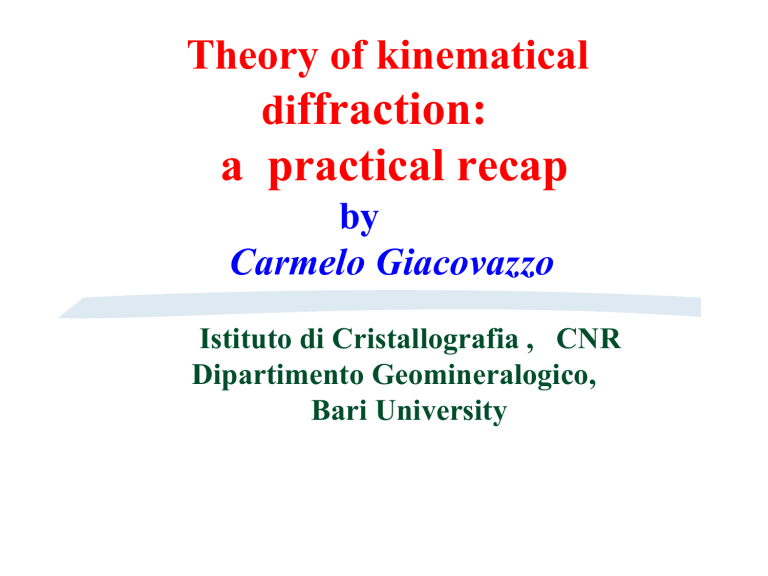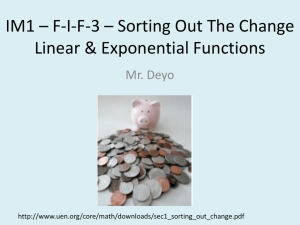Giacovazzo_erice-kinematical

Theory of kinematical di
ffraction: a practical recap
by
Carmelo Giacovazzo
Istituto di Cristallografia , CNR
Dipartimento Geomineralogico,
Bari University
The Thomson scattering model
A X-ray plane wave propagates along the x direction, the scatterer is in O. Q is the observation point, in the plane (x,y).
F = e E ; a = F /m
I eth
= I i sin 2
[e 4 /(m 2 r 2 c 4 )]
is the angle between the acceleration direction of the electron and the observation direction .
If the beam is non-polarised , we can divide the overall incident beam into two components with the same intensity( = 0.5I
i
), the first polarized along the y axis , the second along the z axis.
For the first component φ=(π/2-2θ) and
I ey
= 0.5I
i
[e 4 /(m 2 r 2 c 4 )] cos 2 2
.
For the second component φ=π/2 and
I ez
=0.5 I i
Therefore
[e 4 /(m 2 r 2 c 4 )]
I eTh
=I i
[e 4 /(m 2 r 2 c 4 )] [(1+cos 2 2
)/2]
X-Ray versus e-diffraction
-e-scattering is caused by interaction with the electrostatic field ( sum of nucleus and of electron cloud);
-e-scattering is weakly dependent on the atomic number ( light atom localization)
-e- absorption is strong;
-e-interaction is thousands stronger than X-ray interaction: nanocrystals, dynamical effects
The
Compton effect
The corpuscolar interpretation of the quantomechanics lead Compton to consider an energy transfer from the photon to the electron.
The radiation is incoherent ( no phase relationship between the incident and the
diffuse beam). That induces a wavelength change equal to
=0.024 (1-cos2
)
The interference
We will investigate the interference mechanism which governs the diffusion from an extended body.
We will start with two charged particles, one in O and the other in O’, both interacting with a X-ray beam.
AO = r .
s o
; BO= r .
s ; AO+BO = r .( s s o
)
(AO+BO)/
= r .( s s o
)/
= r .
r * where r *= ( s s o
)/
= 2
r *.
r r*=2sin
/
F( r *) = A o
F( r *) =
j
+ A o’ exp(2
i r *.
r )
A j exp(2
i r *.
r j
) =
j
where f 2 = I/I eth f j exp(2
i r *.
r j
)
4
If the scatterer distribution is a continuoum then
F
S
2
i r * .r
d r
You can easily recognize that the amplityde F( r *) is the Fourier transform of the electron density.
Viceversa
S *
F
2
i r * .r
d r *
The above formulas are quite general: they will be applied to the cases in which
( r ) represents the electron density of an electron, of an atom, of a molecule, of the unit cell, of the full crystal.
The scattering amplitude of an electron
e
2 f e
*
S
e exp 2
i r * .r
d r
An example :
the atom C ( 2x1s;2x2s;2x2p )
(
e
)
1s
= (c
1
3 /
) exp(-2c
1 r);
(
e
)
2s
= c
2
5 /(96
) r 2 exp(-c
2 r)
I coe
+I incoe
=I eTh
I incoe
=I eTh
- I coe
=I eTh
-I eTh f e
2
=I eTh
(1-f e
2 )
6
The Atomic scattering factor
2
a f a
j
Z
1
T
ej a
j
Z
1
j
I coe
=I
=I eTh eTh
(Σ f a
2 j=1,..,Z f ei
) 2
I incoe
=I eTh
(Σ j=1,..,Z
[1-f ej
2 ])
The atomic thermal factor
a
( r ) is the electron density for an atom isolated, located at the origin. Owing to the thermal agitation, the nucleus moves at the instant t into r’ : then the electron density will be
a
( rr’
). Let p( r’
) the probability of that movement: then
at f at
S '
a
r
r'
d r'
a
f a
S ' p
exp
2
i r * r r
.r'
d r '
f a r .
q r
Suppose now that q
p r r
1
2
U
1 exp
/ 2
2
exp
2 Ur
* 2 r
'
2
/ 2 U exp(
where U
8
2 U sin 2
/ r '
2
2 ) exp(
B sin
2
/
2
) where B
8
2
U ( A
2
)
Scattering amplitude of a molecule
Let
j
( r ) be the electron density for an atom isolated, thermically agitated and located at the origin .
Then
( r r j
) will be the electron density of the same atom when its nucleus is in r j
.
Let
M
( r ) be the electron density of a molecule:
.
M
( r )
j
N
1
j
( r
r j
)
F
M
N
j
1
j
r
r j
exp
2
i r * .r
d r
Let us int roduce the change of var iables r
r j
F
M
j
N
1
S
j
j exp
2
i r * .
r j
R j
d R j
j
N
1 f j exp
2
i r * .r
j
R j
.
Then
Scattering amplitude of an infinite crystal
As we know the electron density of a crystal may be expressed as a convolution:
M
The scattering amplitude is then
T
V
1
F
H
1
V
F
M
F
M
.
h , k
, l
r
* r
H
*
h ,
, l
k
r
* r
H
*
where r
H
* h a *
k b *
l c *
Scattering amplitude of a finite crystal
A finite crystal may be represented as the product
cr
where
( r ) is the function form which is equal to 1 inside the volume of the crystal, equal to 0 outside.
Then
F
T
* T
1
V
F
M
H
D
r
* * r
H
where
D ( r
*
)
T
S
exp
2
i r
*
.r
d r exp
2
i r
*
.r
d r
The structure factor
F
H
j
N
1 f j exp
2
i
* r
H
.r
j
j
N
1 f j exp
2
i H X j
A
H
iB
H where
A
H
j
N
1 f j cos 2
H X j
B
H
F
H
j
N
1 f j sin 2
H X j
F
H exp
H with
H
a tan
B
H
/ A
H
The Ewald sphere
OP=r*
H
=1/d
H
= IO sin
= 2sin
/
The Bragg law
2 d
H sin
= n
It may be written as
2(d
H
/n ) sin
=
or also 2d where H
’= (nh, nk, nl).
H’ sin
=
Saying r*= r*
H is equivalent to state the Bragg law: r* = 2sin
/
=1/d
H
The symmetry in the reciprocal space
The Friedel Law
F
H
= A
H
+ iB
H
; F
-H
H
= -
H
= A
H
- iB
H
I
H
I
-H
(A
H
+ iB
H
(A
H
- iB
H
)(A
H
- iB
H
) = A
H
2
)(A
H
+ iB
H
) = A
H
2
+B
H
2
+B
H
2
The intensities show an inversion centre.
The effect of a symmetry operator in the reciprocal space
The general expression of the structure factor is
F
H
N f j exp( 2
i H X j
)
Let C
(R,T) j
1 be a symmetry operator. Consider the quantity
F
H R exp
2
i H T
j
N
1 f j exp
2
i H RX j
exp
2
i H T
j
N
1 f j exp
2
i H ( RX j
T )
F
H
F
H R
F
H exp
2
i H T
| F
H R
H R
|
|
F
H
H
|
2
H T
Find the Laue group
Apply the Friedel law and the symmetry induced law
| F
HR
| =| F
H
| to find the Laue groups.
---------------------------------------------------Laue group
P1 | F h k l
|= |F
P-1 “ “
-h -k -l
| -1
-----------------------------------------------------------
P2 |F hkl
| =| F
-h k -l
|= |F
-h-k-l
|=| F h -k l
Pm ‘’ ‘’ ‘’ ‘’
| 2/m
P2/m
-------------------------------------------------------------
P222 | F hkl
| = | F h -k -l
| = |F
-h k -l
| = |F
-h -k l
| 2/m 2/m 2/m
= |F
-h -k -l
| = |F
-h k l
| = | F h -k l
| = |F h k -l
|
Find the systematically absent reflections
Find the set of reflections for which
H R
H
Once you have found it , check if the product HT is not an integral value. In this case the ( true ) equation
F
H R
F
H exp
2
i H T
is violated, unless |F
H
| = 0.
The reflection is systematically absent.
Space group determination: the single crystal scheme a) First step : lattice analysis , which provides the
Unit Cell parameters. E.g.
a = 11.10(2), b = 14.27(3), c = 9.72(2)
= 90.25(37),
= 89.48(30),
= 90.32(35)
Is the unit cell orthorhombic ?
b) Second step : symmetry analysis
In the example above, three two-fold axes should be present to confirm the orthorhombic nature of the crystal.
The symmetry analysis
1) First step : identification of the Laue group via the recognition of the
“ symmetry equivalent reflections”.
The Laue group generally identifies without any doubt the crystal system ( pseudo-symmetries, twins etc. are not considered).
b) Second step : identification of the systematically absent reflections .
The Laue Group
Symmetry operators :
Then r js
C s
R s r j
( R s
, T s
), s
1,..., m
T s are symmetry equivalent positions in direct space.
In the reciprocal space we will observe the symmetry equivalent reflections h R s
, s
1,..., m
If the space group is n.cs. , the Friedel opposites should be added: the complete set is h R s
, s
1,..., m h R s
, s
1,..., m
The Laue group
1
R
1
0
0
0
1
0
0
0
1
2 m
2 m
2 m
1
R
2
0
0
0
1
0
0
0
1
1
R
3
0
0
0
1
0
0
0
1
1
R
4
0
0
0
1
0
0
0
1
The equivalent reflections are h R
1
(hkl), h R
2
(h k l ), h R
3
( h k l), h R
4
( h k l ),
h R
1
( h k l ),h R
2
( h kl),h R
3
(hk l ),h R
4
(h k l)
The systematically absent reflectio ns
Since
F hR
S we have
F h exp(
2
i hT s
) (1)
F h
,
h , R s
h
2
hT s
If hR s
= h and hT s
=n the relation (1) is violated unless the reflection h is a systematically absent reflection.
F hR
S
The combination of the information on the Laue
Group with that on the systematically absent reflections allows the determination of the
Extinction Symbol .
The extinction symbols (ES)
In the first position: cell Centric type ( e.g., P - - a , in orth.)
Then the reflection conditions for each symmetry direction are given.
Symmetry directions not having conditions are represented by a dash .
A symmetry direction with conditions is represented by the symbol of the screw axis or glide plane.
Table of ES are given in IT per crystal system. There are
14 ES for monoclinic, 111 for orthorhombic, 31 for tetragonal, 12 for trigonal-hexagonal, 18 for cubic system
Extinction symbol and compatible space groups
• ES
P - - P222, Pmmm, Pm2m, P2mm,
Pmm2
( in orth .)
P - - a Pm2a, P2
1 ma, P mma
(in orth.)
P - - P4, P-4, P4/m,
(in tetrag.
) P422, P4mm, P-42m, P-4m2
P4/mmm
P6
1
-P6
1
P6
5
P6
1
22 P6
5
22
Find the reflections with symmetry restricted phase values
Look for the set of reflections for which
H R
H
Since
HR
=
H
- 2
HT for that set of reflections it will be
-H
=
H
-2
HT , or
2
H
=2
HT or
H
=
HT + n
Some exercises
Find the rotation and translation matrices for the space group P4
1
, and
P3
1
;
Find the equivalent reflections for the same space groups;
Find the systematically absent reflections for the space group P2
1
/c,
P4
1
,P3
1
, P2
1
2
1
2
1
The diffraction intensities
I
H
= K
1
K
2
I
0
L P T E |F
H
| 2 where
I
0 is the intensity of the direct beam,
I
H is the integrated intensity of the reflection H,
K
K
2
1
= e 4 /(m 2 c 4 )
=
3
/V
P
polarisation factor (e.g., [1+cos 2 2
]/2
L
Lorentz factor
T
Transmission fctor ( e.g., I/I oss
)
Why integrated intensity?
The diffraction conditions are verified on a domain owing to: a) the finitness of the crystal b)non vanishing divergence of the incident radiation; c) non-monochromatic incident radiation; d) crystal defects
Electron density calculation
1
V
S
*
F
h , k
, l
F hk l
2
i r
* exp
.r
d r
*
2
i H X
1
V h
0 k
l
F
H
F
H
1
V h
0 k
l
F
H exp i
(
H exp
i (
H cos
(
H
2
H X )
2
H X )
2
H X )
Electron density map and finitness of the diffraction data
The limiting sphere (and/or other factors) limits the number of measurable diffraction intensities.
Let
( r *) be the form function of the measured reciprocal space( equal to 1 in the volume containing the measured reflections, equal to 0 elsewere).
Only
F
T
T
F
F
is
available .
Then
* T
Code SG ASU aker a P -4 2
1 m O
14
Mg
2
Al
6
Si
4
Ca
4 anatase b I 4
1
/a m d O
8
Ti
4 barite c P n m a O
16
S
4
Ba
4 charoite d P 2
1
/m Ca
24
K
14
Na
10
Si
72
O
186 cnba e P 2
1
/c C
29
N H
17 gann f P 6
3 m c Ga
2
N
2 mayenite g I -4 3 d O
88
Al
28
Ca
24 mfu41 h F m -3 m Zn
2
Cl N
2
C
3
O mullite i P b a m Al
4.56
Si
1.44
O
9.72
natio j C 2/m O
3
Ti
1.5
Na
0.5
natrolite k F d d 2 Na
2
(Al
2
Si
3
O
10
) (H
2
O)
2 srtio3 l P m -3 m O
3
Ti
1
Sr
1 srtio3_s m P b n m O
12
Ca
4
Ti
4 zn8sb7 n P -1 Zn
32
Sb
28
COLL RES/N
RE
S
P 0.40/339
P
P-A
P-A
A
P
P
P-A
P-A
P-A
P-A
P
P
P-A
0.25/267
0.77/355
1.18/2878
0.76/3975
0.25/170
0.54/228
1.09/655
0.76/213
0.76/517
0.75/743
0.26/180
0.26/464
0.77/3943
COMP
RES
23
22
82
97
83
32
44
96
86
73
99
43
6
54
R int
30.9
14.2
20.6
18.8
13.8
17.0
21.9
4.5
21.5
29.2
8.8
13.8
15.3
13.3
Code aker anatase barite charoite cnba gann mayenite mfu41 mullite natio natrolite srtio3 srtio3_s zn8sb7
1
4
1
1
1
1
1
1
1
1
1
1
1
ORD
L
1
EX
T
ORD7
P -4 21 m 3
ORD8
3
I 41/a m d 1
P n m a 1
1
1
P 21/m
P 21/c
P 63 m c 1
I -4 3 d 1
1
1
F m -3 m 1
P b a m
C 2/m
3
1
1
1
1
2
>100
3
1
F d d 2 1
P m -3 m 3
P b n m
P -1 -
60
1
1
-
36








